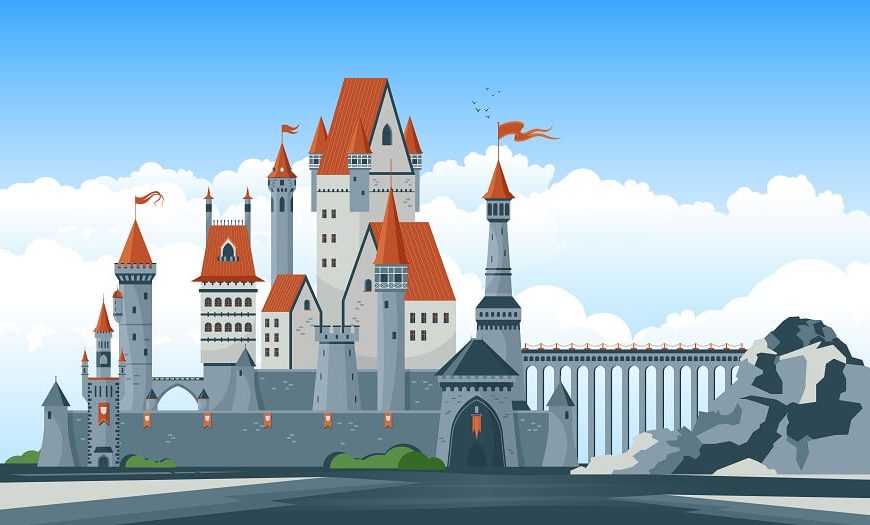Mediaeval castles were built for kings and their nobles during the Middle Ages as a fortified home to protect them from external attacks. The mediaeval period spans around a thousand years starting in 476 A.D. and ending between 1400 and 1450. Most of Europe was ruled by kings and lords at that time and to defend themselves they built huge fortified castles. These were also used to launch attacks of their own. Initially, mediaeval castles were made of wood and timber but later stone was used as a way on how to build a mediaeval castle stronger. They were more often than not built on a hill as that gave them a vantage to help with their defence. With the end of the mediaeval period castles weren’t built as much as cannons and larger artillery came into the scene which could easily knock down the walls of the castle.
Castle Features
Though the castle designs were different throughout Europe, there were some similar parts of a mediaeval castle that remained constant in most castles. All the different parts of a mediaeval castle had a specific role to play.
- A Moat was an integral part of a mediaeval castle and dug around it as a defensive ditch that was filled with water. There was a drawbridge across it to reach the castle and the drawbridge was withdrawn at the event of an access restriction.
- The Keep was a big and tall tower and the last line of defence in a mediaeval castle.
- The Curtain Wall was the wall built around the castle and had a walkway on it from where fire arrows could be shot down on the attackers.
- Arrow Slits were cut into the walls and the archers could shoot arrows at attackers while remaining safe.
- The Gatehouse was situated at the gate and acted as a reinforcement at the weakest point of the castle defence.
- Battlements were cut out of walls and situated at the top of the castle walls. This allowed defenders to attack while remaining protected behind the wall.
Types of Medieval Castles
After the Normans had invaded and conquered England, they began the tradition of building castles that lasted through the thousand years of the mediaeval period. Castles existed in England from the Roman Age but it gained impetus with the Normans and there are 4 types of mediaeval castles that can be found all over England.
Castles Within an Existing Roman Fortress
The earliest mediaeval castles that were built by the Normans were constructed within an existing Roman Fort with some added features.
Motte and Bailey Castles
Motte and Bailey castles were the earliest mediaeval castles that were built by the Normans from scratch. These castles had 2 parts — the Motte and the Bailey. The motte was a very high hill-like structure built of mud on which a wooden lookout or Keep was built. This was surrounded by a Palisade or high wooden fence.
The Bailey was the living quarters of the residents and animals and separated from the Motte by a wooden drawbridge which could be removed if enemies attacked. To give added protection to the castle, The Motte and Bailey were both surrounded by a ditch that could be filled with water.
Stone Keep Castle
These castles soon replaced the Motte and Bailey castles as they were stronger and offered a better form of defence.They were constructed with a stone Keep at the centre, had few windows and had thick walls. The Keep was on the first floor and had stone steps leading up to it The kitchens were on the ground floor while living quarters were situated on the upper floors. Initially the Keeps had a rectangular shape but later ones were made in a circular shape. The Keep was surrounded by a thick stone wall which had turrets that were used as lookouts. The Bailey was outside the Keep and animal shelters and craft shops were built against the walls. The entire stone keep castles were often surrounded by a moat with a drawbridge.
Concentric Castles
Concentric castles were constructed in the 12th and 13th Centuries and were by far the best protection against enemy attacks. The most innovative feature of these mediaeval concentric castles were its walls. It comprised an inner thick stone wall with turrets at intervals and was then surrounded by an equally thick stone wall that was lower in height. The reason for the different level walls was so that the archers positioned at the inner walls could fire over the archers positioned at the outer walls. The space between these 2 walls was referred to as the ‘death hole’ as if the attacker got trapped between these 2 walls, it was sure death for him. These castles too were surrounded by a moat with a drawbridge.
Trivia about Castles
- Initially the towers of a mediaeval castle were rectangular or square but later they realised that round towers offered better visibility and defence, so the design changed.
- Many castles had a room called a buttery in which ale was kept.
- Siege engines like battering rams, ballista and catapults were used to attack castles.
- Attacking armies often would set up camp or siege outside the castle and try to starve out the castle residents as opposed to attacking them. As a result, many castles were built on a spring so that they would have sufficient water in the event of a siege.
- The affairs of the castle were managed by a steward.
- Cats and dogs were encouraged in castles as they kept rats at bay and the grain stores safe.
Mediaeval castles were like a township in themselves with royalty, nobles, the common man and animals all living together. The king’s responsibility was to look after the welfare of the people and protect them from external aggressors. For this reason, the mediaeval castles were fortified and the structure of the castles changed with time to make them more secure. Do visit the website of EuroKids to get more information on mediaeval castles and an appreciation of life in mediaeval Europe.
















